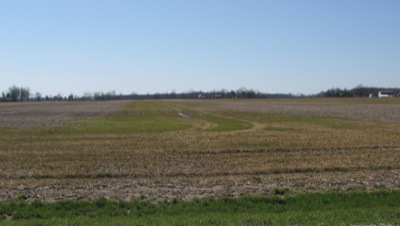Tuesday, April 17th, 2007
Some of county's wheat not so good
Damaged wheat acres likely to go to corn; but check with FSA first
By Nancy Allen

Photo by Nancy Allen/The Daily Standard
This wheat field along the west side of Celina-Mendon Road contains huge bare patches and standing water in some areas. Much of the wheat that is still alive is brown. Though not widespread, some of the county's wheat did not fare too well over the winter and in recent weeks when a spate of freezing weather damaged some of it further.
Some of the county's wheat has been damaged due to late and less than ideal planting conditions last fall, torrential rains in February and freezing weather in recent weeks.
Though the problem is not widespread, it likely will cause some farmers to tear up their wheat fields and plant corn, especially in light of the high market prices for corn right now.
"It's probably a combination of a couple of different things," said Mercer County OSU Extension Agent Todd Mangen about what damaged the county's wheat. "Mostly it was the cold ... and it wasn't just cold, it was freezing."
To a much lesser degree, some wheat also was burned by fertilizer, he said.
Mangen said some of the wheat looked good up until about three weeks ago, when a patch of 60-to 70-degree weather pushed it out of its dormancy and made it green up. But then temperatures dropped below freezing and stayed there.
"We had some pretty good-looking wheat at first, then we got rain and ponding water on it and then came the freezing weather," he said.
The later in its growth stage the wheat was when it was hit with freezing weather, the more damage it received, Mangen explained, because more of the plant's growth point was exposed. The growth point is the main part of the plant that continues to get taller as it grows. If it is damaged badly, the plant dies.
Which wheat suffered the most damage also depended on the variety, Mangen said. Varieties that do not stand up to cold as well fared the worst, he said.
Mangen said he did not know how much of the county's wheat crop was damaged. He urged producers to scout their wheat fields and check the growth point for damage to determine whether or not to destroy it.
"You want a growth point that is either white or cream-colored," he said. "When you start seeing brown growth points, that means the plant is gone."
According to Mercer County Farm Service Agency Executive (FSA) Executive Director Chris Gibbs, who did some cursory scouting of fields, wheat in the southern part of the county appears to have faired a bit better than that in the northern part.
Though some producers may be thinking about tearing up their wheat to plant corn, Gibbs said there are some things to consider.
Before a producer destroys their wheat, they should contact the county FSA office to maintain wheat history credit to be eligible for future USDA programs.
"USDA programs can only be maintained if FSA is notified of the wheat prior to it being destroyed," Gibbs said, adding that there is no charge for timely filed acreage reports.
Producers with crop insurance also should contact their agent to ensure contract terms and conditions are met before insured wheat is destroyed.
In 2005, Mercer County producers harvested 22,800 bushels of wheat at about 80 bushels to the acre, ranking the county seventh in the state for wheat production, USDA agricultural statistics show.



